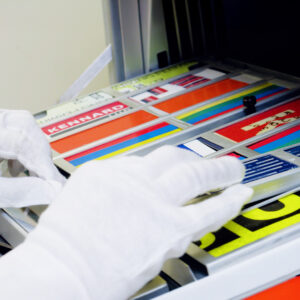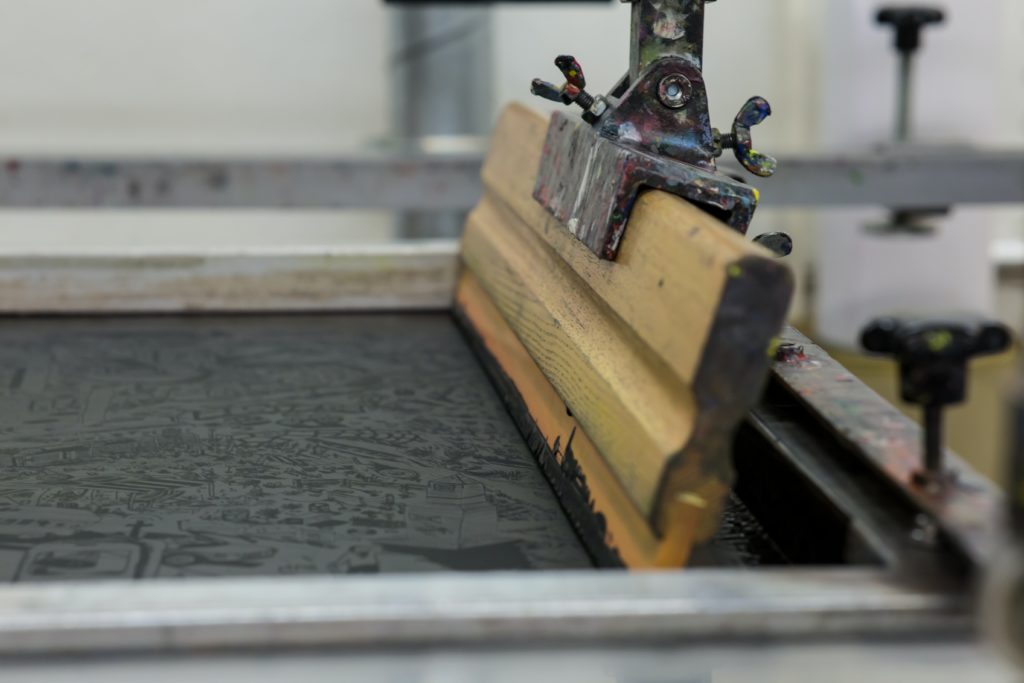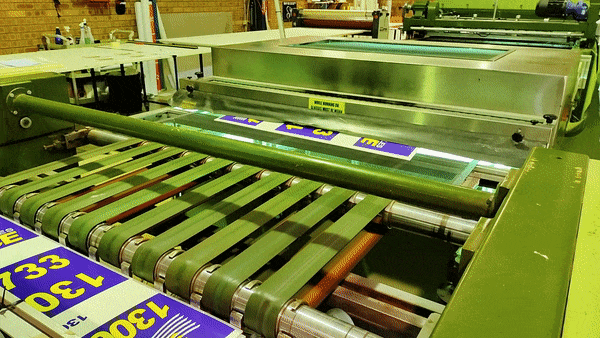
Are you interested in how screen printing works? We are going to give an outline of this printing technique and answer a few questions you may have.
At Signprint have been using the screen printing for decades. We screen print onto various surfaces and create signage for major companies across a range of industries, hence we are very familiar with this technique and can help you decide if it is the ideal printing option for your project or signage.
Screen printing is a traditional printing method which involves printing a stencilled image onto a surface by applying paint through a mesh screen. It is popular due to its ability to produce vivid coloured prints along with being able to print the same design multiple times making it easy to mass produce a print.
Screen printing can be done on various surface types from metal, plastic flute board, vinyl, fabric and more. The ink is mixed to achieve almost any colour with high accuracy.
Screen Printing was invented in China between 960-1279AD, it was later adopted by Japan and Egypt. Europe was introduced to this printing methods later in the 18th century, but it wasn’t popular until silk became more common and cheaper, which is what was used to make the screen mesh. Screen printing is also used for artistic purposes. Artists such as Andy Warhol and his screen-printed piece Marilyn Diptych is an example of using screen printing for artistic purposes.
Screen Printing uses a mesh screen which is stretched over a metal or wooden frame. Previously this mesh used to be made from silk but now synthetic polymers like nylon and polyester fabrics are used as they offer the same quality of functionality at a cheaper price. The thread count of the screen determines the end result as it affects the print detail, colour intensity and even the type of ink that can be used. The higher the thread count the thinner and more detailed the thread, a standard thread count is around 110.
Creation of a stencil is part of the screen-printing process. The design is printed onto a transparent film, this is usually an acetyl film which blocks UV light. The film is then placed over the mesh screen and exposed to UV rays. This film is the key in creating a stencil as it helps create the design
One key component is the ink. Choose an ink that is suited for your printing needs, if you are printing on fabric then use a waterproof ink that won’t wash off. Different types of ink are used to give different aesthetic to the print or for functionality purposes.
A squeegee is a tool made up of a flat blade and a handle, the blade is made of rubber and has a blunt edge. It is used to apply and spread paint or any such liquid across a flat surface.

This is the section where the screen is washed to remove excess emulsion before printing or to completely clean the screen so it can be re-used. You can use a hose and water or even cleaning fluids to remove the emulsion.
The process of setting up screen printing is a rather long process, starting with the creation of the stencil and mesh.
The first step to screen printing is to print out the intended design onto a transparent film which is later going to be used to create a stencil. This design can be digitally printed, or hand drawn.
The mesh is important as it determines how thick or thin the paint will be and the complexity or how detailed the image will be. After the mesh count is determined the screen is coated in an emulsion which will be used to create the stencil.
The film is placed onto the screen and exposed to UV light which hardens the exposed emulsion. The unexposed emulsion directly under the print does not harden and is washed off revealing the stencil of the design. The process is repeated for each colour required.
Now that the stencil is complete, place the screen over the surface you intend to print on. Apply and spread the ink on top of the mesh screen and use a squeegee to spread the ink across the screen, and onto the lower surface through the open sections of the stencil. Lift the screen to reveal the design.
A printing press can be used to automate some of the processes increasing the production rate. An automatic printing press is an efficient way to print on multiple surfaces quickly and print using multiple screens at a time. The printing process can also be done by hand using a squeegee.
Once the product or surface is printed on it is then passed through a curing process to harden the ink.
Screen Printing is a rather popular printing technique used for commercial and artistic purposes and this is due to the characteristics that make this technique unique.
The colour produced through this printing techniques are vivid due to layering of the ink by the mesh. The spot colouring method produces more vivid and solid colours. This is ideal for achieving accurate colours that are ‘on brand’ and printing on darker surfaces and hence is a popular option for printing on fabrics and textiles.
In screen printing the same stencil can be used to print on multiple surfaces hence making it ideal for printing large batches of the same design. Using an automated printing press hastens the process immensely while also improving accuracy.

Screen Printing is a low-cost printing method especially when printing a large batch, although the cost of the print increases with the number of colours required for the image.
Due to the composition and thickness of the ink build, the print and colour created through screen printing tends to be much more durable than other forms of printing and can withstand heat, water, U.V and physical damage which minimises deteriorating or fading. Various grades of inks are available with differing qualities to perform in a range of applications.
Screen printing is not always the preferred printing choice as there are certain limitations and disadvantages which make is unsuitable for some industries and types of work.
Screen-printing can be cost prohibitive in small batches due to the amount of preparation needed compared other techniques like digital. Additionally if multiple colours are required costs increase.
The screen-printing method is labour intensive; hence the job turnaround is not as quick as digital methods.
In screen printing only one colour is applied at a time hence trying to create a multi coloured print takes much longer as each layer of colour would have to be applied one after the other. Preparing multiple screens is tedious and requires longer preparation time.
Screen Printing is ideal for people who want vivid print colours, want to print on fabrics and textiles or want to print large volumes of the same design while being cost effective. Screen printing is also ideal for artists as this printing technique is often used to create art, as briefly mentioned before, such as pop art.
At Signprint we have various screen-printing lines including an automated multicolour press. Colours can be mixed in our ink room and matched to Pantone specifications. Our in-house accelerated weathering lab is used to determine which ink will perform best in given circumstances. In the interests of the environment, we primarily use UV cure inks which eliminates solvents. We have a wastewater reclamation system to reduce wastewater from the cleaning processes. We use both CMYK or spot colouring technique, with the spot printing technique producing more vivid colours and detailed images.
If you would like to learn more about different forms of printing or just want to request a quote then you can contact us, the contact information is available here.
Monday 7:30am-400pm
Tuesday 7:30am-400pm
Wednesday 7:30am-400pm
Thursday 7:30am-400pm
Friday 7:30am-400pm
Saturday Closed
Sunday Closed